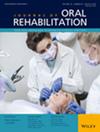Therapeutic Exercise Effects on Activity, Participation and Quality of Life in Individuals With Temporomandibular Disorders: A Systematic Review
Abstract
Background
Temporomandibular disorders (TMDs) are common musculoskeletal jaw conditions that can significantly impact individuals' activity, participation and quality of life (QOL). Current clinical recommendations for TMD management encompass therapeutic exercise, although it is unclear how exercise impacts recovery beyond improving individuals' jaw pain and range of motion.
Objective
To investigate the effects of therapeutic exercise on patient-reported measures of activity, participation and corresponding QOL in individuals with TMD.
Methods
An electronic database search of PubMed, Embase, CINAHL and Cochrane Central was performed on 7 March 2024. Inclusion criteria were peer-reviewed journal articles written in English that investigated the effect of therapeutic exercise on activity, participation or QOL in individuals with TMD. Risk of bias was assessed, and data were grouped according to outcomes then analysed using a narrative synthesis approach. The confidence in cumulative evidence for each outcome was determined using a modified GRADE approach.
Results
Twelve studies were eligible for this review, comprising a total of 775 participants (mean age = 32.5 years, 79% female). Therapeutic exercise interventions included both global (e.g., aerobic, core, relaxation, postural) and local jaw-specific (e.g., mobility resistance) exercises. Findings suggest that both jaw-specific and global exercises may improve activity, participation and QOL in patients with TMDs. These findings should be considered with caution as confidence in cumulative evidence was very low.
Conclusion
Therapeutic exercise may be effective in improving activity, participation and QOL in individuals with TMDs, although further research is needed to improve the quality of the evidence and to direct clinical guidelines.


 求助内容:
求助内容: 应助结果提醒方式:
应助结果提醒方式:


